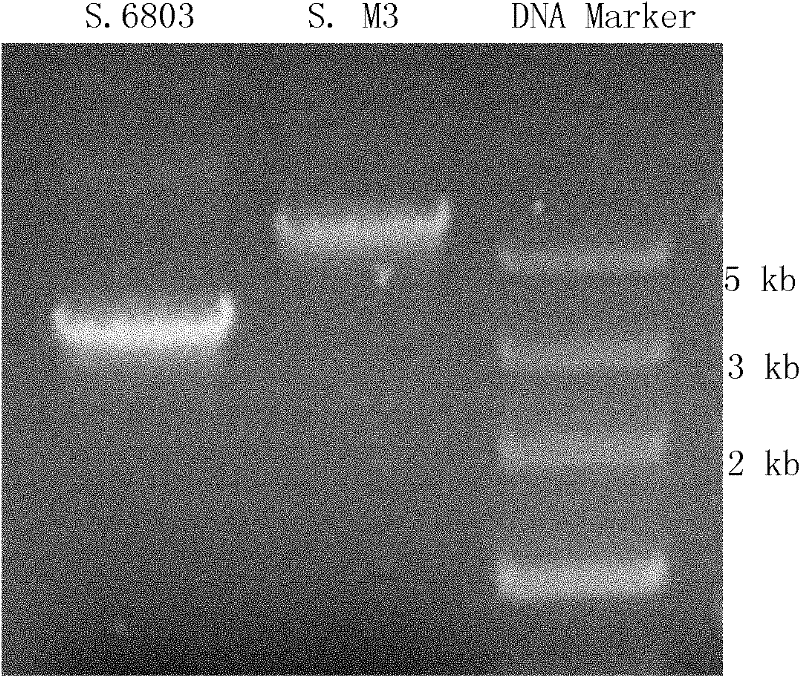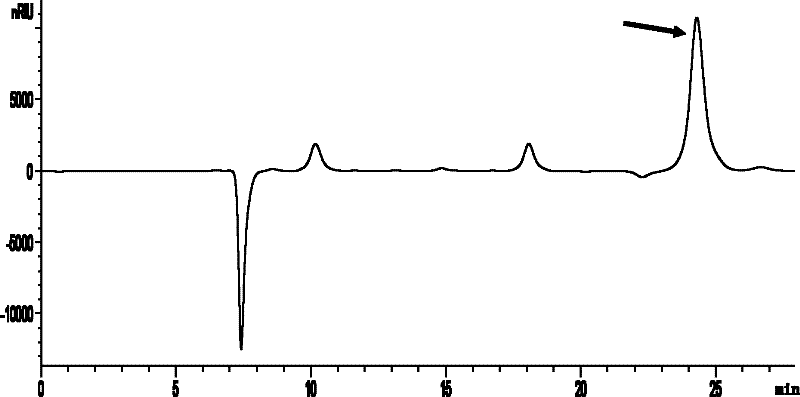Technique for biotransforming CO2 into isopropyl alcohol by utilizing blue algae
A technology of isopropyl alcohol and cyanobacteria, applied in the field of recombinant cyanobacteria, can solve the problems of unable to achieve sustainable development of renewable energy, aggravate the shortage of fossil energy, and not solve the problem of developing bioenergy and food.
- Summary
- Abstract
- Description
- Claims
- Application Information
AI Technical Summary
Problems solved by technology
Method used
Image
Examples
Embodiment 1
[0070] Embodiment 1, application freshwater cyanobacteria produces isopropanol
[0071] Establishment of the isopropanol synthesis pathway in the freshwater cyanobacterium Synechocystis sp. 6803. Since there is acetyl-CoA acetyltransferase in Synechocystis sp., the genes encoding acetoacetyl-CoA transferase (ctfAB), acetoacetate decarboxylase (adc) and alcohol dehydrogenase (adh) are expressed in Synechocystis sp. ), the isopropanol synthesis pathway can be established.
[0072] 1. Construction of the recombinant plasmid pHR-ctfAB::adc::adh (Syneocystis homologous recombination integration expression vector)
[0073] 1. Acquisition of acetoacetyl-CoA transferase gene ctfAB and acetoacetate decarboxylase gene adc
[0074] ctfAB and adc are two adjacent genes on the Clostridium acetobutylicum genome. Therefore, the genomic DNA of Clostridium acetobutylicum was used as a template, and the primer pair composed of ctfABF and adcR was used for PCR amplification to obtain a PCR pr...
Embodiment 2
[0118]Embodiment 2, application freshwater cyanobacteria produces isopropanol and / or acetone
[0119] In the freshwater cyanobacterium Synechocystis 6803, the acetone pathway was established first, and the isopropanol pathway was established on the basis of acetone production. From figure 1 It can be seen from the synthesis route of isopropanol that isopropanol is derived from the dehydrogenation of acetone. Therefore, in this embodiment, it is carried out in two steps, that is, to obtain acetone-producing recombinant algae first, and then introduce alcohol dehydrogenase into the recombinant algae to obtain isopropanol-producing recombinant algae. Using the poly-β-hydroxybutyrate synthase gene (pha) on the Synechocystis genome as an integration platform, the genes encoding acetoacetyl-CoA transferase (ctfAB) and acetoacetate decarboxylase were expressed in Synechocystis sp. The gene (adc) was used to establish the acetone synthesis pathway; the gene encoding alcohol dehydrog...
Embodiment 3
[0170] Embodiment 3, application seawater cyanobacteria produces isopropanol (isopropanol synthesis pathway is established in seawater cyanobacterium Synechococcus 7002)
[0171] 1. Construction of recombinant plasmid pHR-thl::ctfAB::adc::adh (Synechococcus homologous recombination integration expression vector)
[0172] 1. Acquisition of the coding gene (thl) of acetyl-CoA acetyltransferase
[0173] Since there is no acetyl-CoA acetyltransferase in Synechococcus, it is necessary to express the enzyme in Synechococcus. The genomic DNA of Clostridium acetobutylicum was used as a template, and the primer pair composed of thlF and thlR was used for PCR amplification to obtain a PCR product (about 1100 bp), which was the thl gene.
[0174] thlF: 5'-ATGAAAGAAGTTGTAATAGC-3'
[0175] thlR: 5'-CTAGCACTTT TCTAGCAAT-3'
[0176] 2. The thl gene, the ctfAB-adc fusion gene of Example 1 and the adh gene of Example 1 are simultaneously used as templates, and the primer combination composed ...
PUM
 Login to View More
Login to View More Abstract
Description
Claims
Application Information
 Login to View More
Login to View More - R&D
- Intellectual Property
- Life Sciences
- Materials
- Tech Scout
- Unparalleled Data Quality
- Higher Quality Content
- 60% Fewer Hallucinations
Browse by: Latest US Patents, China's latest patents, Technical Efficacy Thesaurus, Application Domain, Technology Topic, Popular Technical Reports.
© 2025 PatSnap. All rights reserved.Legal|Privacy policy|Modern Slavery Act Transparency Statement|Sitemap|About US| Contact US: help@patsnap.com



